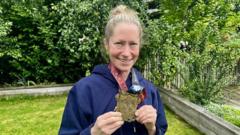Can an Ultra-Marathon Winner Really Finish Before Others Even Start?

Inspiring Journey of a Scottish Ultra-Runner: Anna Rutherford's 100-Mile Triumph
In the world of ultra-running, few stories resonate as powerfully as that of Anna Rutherford, a Scottish lawyer and mother-of-three, who recently accomplished an extraordinary feat. Finishing the inaugural Rat Race, a grueling 100-mile journey from Bamburgh Castle in Northumberland to Edinburgh Castle, Anna completed the race in an astounding 17 hours and 23 minutes—over two hours ahead of the nearest male competitor. Her story is not just one of speed and endurance; it's a testament to resilience, determination, and the evolving landscape of women in endurance sports.
A Unique Challenge: The Inaugural Rat Race
Taking place on a scenic route that spans the east coast of Scotland, the Rat Race provides a challenging landscape that includes picturesque coastal views, rolling hills, and historic landmarks. The race kicked off early on a Saturday morning, with Anna starting her journey at approximately 07:00. By the time she crossed the finish line just after 00:30 on Sunday, she had not only cemented her place in the race's history but also set a remarkable benchmark for future competitors.
A Race Like No Other
What makes Anna’s achievement even more inspiring is the way she navigated the race both physically and mentally. Initially, Anna kept pace with the leading competitor until about halfway through, when she made her move and sprinted ahead for the last 50 miles, running solo. This mental fortitude is crucial in ultra-running, where the mind often battles as fiercely as the body.
Finding Motivation in Music
During her race, Anna found unique ways to keep her spirits high. She recounted how she sang Dolly Parton’s classic "9 to 5" as she ran up the Royal Mile towards the finish line. This moment not only underscores her passion for music but also highlights how runners can use creativity to overcome physical challenges. The camaraderie she felt from fellow competitors who joined in her singing added to the overall experience, showcasing the community that often emerges in such events.
The Heartfelt Moments
In a touching moment that speaks to Anna's character, she paused during the race to check on a man lying flat on his back near a golf course. While he assured her he was simply "looking at the stars," this interaction exemplifies the human connections that can form even in the toughest circumstances. It’s these heartfelt moments that make endurance sports more than just a test of physical limits; they remind participants of the importance of compassion and community.
The Rigorous Training Regimen
Anna’s journey to this monumental achievement wasn’t without its challenges. She undertook an intense training schedule leading up to the race, logging about 120 miles (193 km) a week at the peak of her preparation. Such rigorous training can take a toll on the body, and Anna experienced concerning symptoms that landed her in the hospital for treatment. This serves as a reminder of the physical demands of ultra-running and the importance of listening to one’s body during training.
Fueling the Body for Success
Nourishment plays a critical role in an ultra-runner's performance. During this race, Anna adapted her nutrition strategy, mixing stock powder with pretzels and consuming gels at designated hydration points every ten miles. Unfortunately, she did miss one crucial feeding point, where she had left gels and a supportive note from her son. This small setback highlights the meticulous planning required for such long-distance events and the emotional support that can motivate runners through tough patches.
Overcoming Mental Blocks
Throughout her race, Anna drew inspiration from fellow ultra-runner Jasmine Paris, who is renowned for her mental strength and success in the sport. Anna shared her insights on the psychological aspects of endurance running, noting that around 70 to 80 percent into the race, fatigue sets in, and mental resilience becomes paramount. She embraced the challenges, recognizing the mental “pain cave” that many ultra-runners must navigate. This highlights the dual nature of ultra-running, where mental toughness is as crucial as physical endurance.
Women in Endurance Sports
Anna’s success is particularly significant in the context of gender representation in endurance sports. She praised the race organizers, Rat Race Adventures, for implementing female-specific provisions at each checkpoint, including dedicated toilets and sanitary products. This thoughtful approach acknowledges the unique needs of female athletes, reinforcing that women are not merely competing but thriving in a space traditionally dominated by men. Anna’s journey showcases that women, regardless of age or hormonal status, can excel in endurance sports.
Breaking Barriers
At 43 years old and navigating the complexities of perimenopause, Anna’s story serves as an empowering example for women everywhere. She openly discussed the hormonal changes that can impact performance and the importance of addressing these challenges. Anna’s transparency about her experience encourages other women to pursue their passions, no matter their life stage, and challenge the stereotypes often associated with aging and athleticism.
The Future of Women in Ultra-Running
As Anna reflects on her remarkable achievement, she hopes it inspires other women to break barriers in endurance sports. Her success not only highlights individual determination but also calls attention to the potential for women to close the gap in ultra-running. The narrative surrounding female athletes is evolving, and Anna's triumph signals a bright future for women in sports.
Conclusion: A Journey of Triumph
Anna Rutherford's incredible performance in the inaugural Rat Race is more than just a personal victory; it's a celebration of resilience, community, and the ever-growing representation of women in endurance sports. As she heads home to rest, her story serves as a powerful reminder that with determination, creativity, and the right support, we can overcome any obstacle that lies ahead.
FAQs
What motivated Anna Rutherford to run the 100-mile race?
Anna was motivated by her passion for running and the challenge of completing a 100-mile race. Her previous achievements in ultra-running also fueled her desire to push her limits further.
How did Anna prepare for such a challenging race?
Anna prepared by following a rigorous training schedule, running approximately 120 miles per week, and adjusting her nutrition strategy to fuel her performance effectively.
What support did Anna receive during the race?
Anna benefited from having her parents at the finish line, as well as well-organized race provisions, including female-specific amenities, which helped cater to her needs as a woman athlete.
How can women overcome challenges in endurance sports?
Women can overcome challenges in endurance sports by seeking supportive environments, addressing their unique needs, and drawing inspiration from role models like Anna Rutherford and others in the field.
As we reflect on Anna's journey, it prompts us to consider: What barriers will you challenge in your life? #UltraRunning #WomenInSports #EnduranceAthlete
Published: 2025-07-20 16:49:10 | Category: technology



